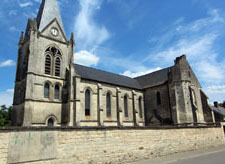Laval-en-Laonnois (Aisne, France) - Saint-Nicolas
- Disclaimer
The dating found here is based on the work of John James, and is meant on this site to serve as a starting point. James' dating is derived from a system that uses his interpretation of the development of capitals over time as the basis for chronology, among other factors. His goal is to refine the dating to within years rather than decades. I have not fully embraced James' methodology, and will be developing this page from its current state to one which is admittedly more conservative. The relative expenditure values found in the Timeline are also based on James' work, and I believe these to be reasonably reliable. They are intended only to give a sense of the amount of work involved in each decade.
I have added the idea of the "project" as a way of separating work in buildings. In my mind, a "project" is a discrete section of work in a building that resulted from the one-time acquisition of funding. "Projects" are generally separated by at least a decade where no work was being done. It is my view that it would have been unwise to start a "project" that could not be finished and protected from the elements, and as such a "project" usually involved a wing or multiple wings of a building, from floor to roof. Rural churches, which could only secure small amounts of funding at irregular intervals, often were the result of many small projects, while the great churches, which benefitted from relatively consistent funding, may have involved only a few large projects.
I have added the idea of the "project" as a way of separating work in buildings. In my mind, a "project" is a discrete section of work in a building that resulted from the one-time acquisition of funding. "Projects" are generally separated by at least a decade where no work was being done. It is my view that it would have been unwise to start a "project" that could not be finished and protected from the elements, and as such a "project" usually involved a wing or multiple wings of a building, from floor to roof. Rural churches, which could only secure small amounts of funding at irregular intervals, often were the result of many small projects, while the great churches, which benefitted from relatively consistent funding, may have involved only a few large projects.
- Timeline with Relative Expenditure (if available, in building units)
 |
 |
 |
 |
- Project A - 1180s - Phase 1 - east (b)
3 courses all round (excluding crossing) with the old church in the way so had to be built inside to top of torus or just above; with a hexagonal staircase
- Project A - 1180s - Phase 2 - east (a)
East with round-arch dado; coursing steps down to north chapel, and then to lowest courses to opening into nave.
- Project B - 1210s - Phase 3 - w crossing, nave
South side of west crossing piers look similar, the large shafts for future nave arcade intending aisles
- Project B - 1210s - Phase 4 - s nave (a)
South nave caps
- Project B - 1220s - Phase 5 - w crossing, nave
Ditto, north side but different dimensions and shafts not same
- Project B - 1220s - Phase 6 - n nave (a)
North nave caps
- Project B - 1220s - Phase 7 - crossing (c)
Both crossing clerestory caps, though crossing piers set out at different times with north and west transept walls, openings.
- Project B - 1230s - Phase 8 - transepts
Transepts and their vaults in whih the outer caps not with crossing, but probably later; confused stonework around north side of opening into nave, and similarly on the south.
